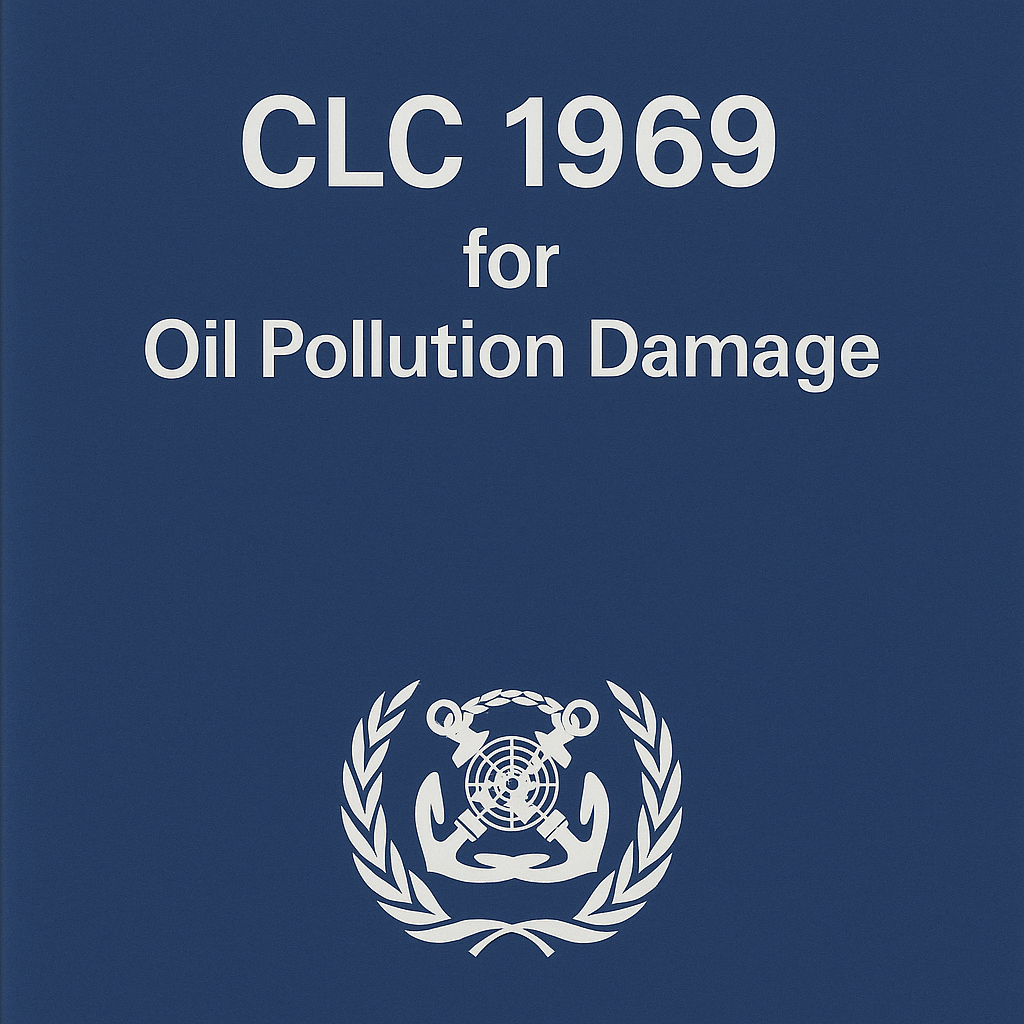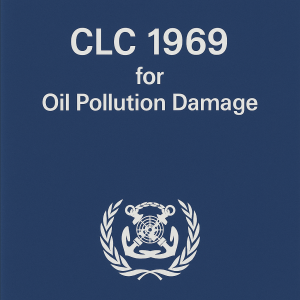Explore the top 10 legal obligations under the 1969 CLC Convention. Learn how shipowners, insurers, and states must respond to oil pollution damage—and why this international treaty still matters today.
Why the CLC 1969 Still Matters in Maritime Law
Oil spills are among the most catastrophic events in maritime history. When crude oil leaks into the ocean, the damage spreads fast and wide—killing marine life, contaminating coastlines, and destroying local economies. The 1967 Torrey Canyon disaster off the coast of the UK—spilling 119,000 tonnes of crude oil—was the wake-up call that led to the 1969 International Convention on Civil Liability for Oil Pollution Damage (CLC 1969).
Now adopted and enforced by over 130 countries, the CLC 1969 and its Protocols (especially 1992 and 2000) form the legal backbone for liability, compensation, and clean-up efforts following tanker-related oil pollution. If you’re a shipowner, insurer, operator, or port authority, understanding these obligations isn’t just useful—it’s legally essential.
This article breaks down the top 10 legal obligations under the CLC 1969, using real-world cases, practical compliance tips, and references to IMO protocols and shipping industry best practices.
Understanding the CLC Convention and Its Role in Oil Pollution Response
The CLC 1969 creates a strict liability regime for shipowners responsible for oil pollution damage caused by persistent oil from tankers. This means claimants do not have to prove fault—only that damage was caused by a qualifying ship.
It operates on three legal pillars:
-
Strict but limited liability of the shipowner.
-
Mandatory insurance.
-
Direct action against insurers.
The CLC is closely connected to the International Oil Pollution Compensation Funds (IOPC Funds) and is implemented alongside the Fund Convention 1992 in most jurisdictions.
1. Shipowners Are Strictly Liable for Oil Pollution Damage
Shipowners are automatically liable for oil pollution damage caused by their vessel—even without negligence.
Exceptions include:
-
Natural disasters (force majeure).
-
Acts of war or sabotage.
-
Damage caused intentionally by third parties.
-
Failure of the coastal state to maintain navigational aids.
However, in practice, courts often apply a narrow interpretation of exceptions, placing the burden of proof on the owner.
Real-world example:
In the Erika oil spill (France, 1999), courts ruled the shipowner was liable under the CLC, even though poor classification and substandard conditions were contributing factors.
2. Obligation to Maintain Financial Security (Compulsory Insurance)
Ships carrying more than 2,000 tonnes of persistent oil in bulk must carry a certificate of insurance or financial security.
This certificate:
-
Is issued by the flag state.
-
Proves coverage up to the limit set by the CLC or 1992 Protocol.
-
Must be carried onboard and presented during Port State Control inspections.
Approved insurers include Protection and Indemnity (P&I) Clubs, which cover most international tankers.
Failure to carry this certificate may result in detention, refusal of port entry, or heavy fines.
3. Display and Validity of the CLC Certificate Onboard
Shipowners must ensure the CLC Certificate is onboard and valid at all times. The certificate:
-
Is issued under Article VII of the CLC 1969.
-
Is often integrated into flag state documentation.
-
May be checked by Port State Control or coastal state inspectors.
Best practice: keep both digital and hard copies available for quick access. The absence of a certificate can lead to denial of port services or legal detention.
4. Compensation Must Be Paid Promptly Upon Claim Validation
Once a valid claim is filed and verified, the liable shipowner (or insurer) must pay compensation promptly, up to the legal liability limit.
Eligible claims include:
-
Costs of preventive measures.
-
Clean-up and recovery operations.
-
Environmental restoration.
-
Economic losses (e.g., fisheries, tourism).
Payment delays can trigger civil proceedings, loss of insurance coverage, and damage to the operator’s standing with classification societies and charterers.
5. Limitation of Liability Based on Ship Tonnage
Under the CLC 1992 Protocol:
-
Ships up to 5,000 GT: liability capped at 4.51 million SDR (~USD 6 million).
-
Ships between 5,001 and 140,000 GT: add 631 SDR per GT.
-
Above 140,000 GT: cap at 89.77 million SDR (~USD 120 million).
Special Drawing Rights (SDR) is the unit used by the International Monetary Fund (IMF) for legal limits.
Limitation does not apply if:
-
The owner acted with gross negligence or intent to cause damage.
6. Obligation to Notify Authorities Immediately After a Spill
In the event of an oil spill:
-
The Master or owner must notify coastal authorities immediately.
-
Initial reports must include location, type of oil, estimated quantity, and preventive measures taken.
-
Follow-up documentation is required within days.
Failure to report can be a criminal offence in many jurisdictions under MARPOL and national legislation.
Real-world case: The Prestige (2002) spill showed how delayed reporting and miscommunication can worsen environmental and legal consequences.
7. Full Cooperation with Clean-up and Investigation Authorities
Owners are legally obligated to:
-
Cooperate with flag state, coastal state, and port state authorities.
-
Allow access to ship documents, maintenance records, and crew logs.
-
Participate in incident investigations and liability assessments.
Non-cooperation can lead to:
-
Legal liability extension.
-
Suspension of insurance coverage.
-
Long-term reputational damage.
8. Obligation to Fund Preventive Measures
Even if no damage occurs, if an oil spill is imminent or probable, the shipowner is responsible for funding preventive measures.
This includes:
-
Booms, skimmers, dispersants, and tugboats.
-
Coordination with national response teams.
-
Temporary cargo transfers (STS operations) to avoid escalation.
These costs are claimable under CLC, but only if measures are deemed reasonable and proportionate.
9. Participation in the IOPC Fund Scheme
Countries party to the CLC typically also participate in the International Oil Pollution Compensation Funds (IOPC Funds).
If the shipowner’s liability limit is exceeded:
-
The IOPC Fund steps in to pay additional compensation.
-
The Supplementary Fund (2003 Protocol) can increase coverage to USD 1 billion.
Shipowners indirectly support this system through oil import levies collected from oil receivers in member states.
10. Obligation to Avoid Unseaworthiness and Negligence
While CLC allows for limited liability, that protection is void if:
-
The shipowner is proven to have acted recklessly.
-
The ship is substandard, poorly maintained, or operating with invalid class certification.
Classification societies like RINA, DNV, and BV provide annual surveys and documentation to prove seaworthiness.
Failure to comply may result in:
-
Unlimited liability.
-
Criminal charges under national environmental laws.
-
Exclusion from P&I cover.
Real-World Application: The Hebei Spirit Incident
In 2007, the Hebei Spirit—an anchored VLCC—was struck by a crane barge off South Korea. Despite being the victim, the shipowner was held liable under the CLC for clean-up costs and damages, as strict liability still applied.
The case demonstrated how:
-
Even passive parties may face liability.
-
Legal processes can involve multiple jurisdictions.
-
Transparency and rapid claims processing reduce long-term impact.
FAQ: Legal Questions About the CLC 1969
Q1: Does the CLC apply to all ships?
No. It applies primarily to tankers carrying persistent oil in bulk, typically above 2,000 GT.
Q2: Can a state claim compensation under the CLC?
Yes. Coastal states, local governments, and even private citizens can file claims under the Convention.
Q3: Is gross negligence always proven in court?
Not easily. Claimants must provide clear evidence, but recent cases have broadened what qualifies as “reckless” behavior.
Q4: What happens if the ship doesn’t have a valid certificate?
Port State Control can detain the vessel, fine the operator, or deny entry. Insurers may also void coverage.
Q5: How does the Fund Convention interact with CLC?
The Fund Convention complements CLC, ensuring victims are fully compensated if the shipowner cannot meet the claim in full.
Conclusion
The 1969 CLC Convention and its updates are not relics of the past—they are living legal tools used every day to hold polluters accountable, safeguard marine life, and ensure victims of oil pollution get compensated fairly.
Whether you’re a shipowner navigating insurance paperwork or a maritime student learning about environmental law, these 10 obligations are the backbone of ethical and lawful tanker operations.
As the world pushes for cleaner seas and stricter accountability, the CLC will remain one of maritime law’s most essential conventions—anchoring justice, responsibility, and protection for all.
References
-
International Maritime Organization. (n.d.). Civil Liability Convention (CLC 1969)
-
IOPC Funds. (2024). Compensation and Fund Mechanisms
-
EMSA. (n.d.). Marine Pollution Response
-
DNV. (2023). CLC Insurance and Liability Guide
-
Paris MoU. (2023). PSC Inspection Trends
-
Lloyd’s List Intelligence. (2023). Global Risk Review: Oil Pollution & Maritime Law
-
UNCTAD. (2023). Review of Maritime Transport


